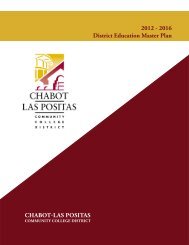City College of San Francisco - California Competes
City College of San Francisco - California Competes
City College of San Francisco - California Competes
You also want an ePaper? Increase the reach of your titles
YUMPU automatically turns print PDFs into web optimized ePapers that Google loves.
THEME II<br />
The English Department’s various SLO initiatives are still in the early stages <strong>of</strong> development and implementation.<br />
Only the English 94 common exam has been used long enough to produce preliminary<br />
evidence <strong>of</strong> its effectiveness. But the preliminary evidence is significant. Comparing Fall 1999 to Fall 2003,<br />
student retention increased from 70.6 percent to 77.2 percent, and success rates increased from 53.8 percent<br />
to 61.4 percent. 10 Not only are more students staying in the classes, but more students are succeeding<br />
in those classes. During this same period, there have also been positive changes in the retention and<br />
success rates for the courses that lead into and follow English 94. While it is not possible to attribute all<br />
<strong>of</strong> these positive developments to the implementation <strong>of</strong> the English 94 common exam, it is quite clear<br />
that the changes that the common exam effected in the Department are having a substantial impact on<br />
teaching and learning.<br />
Why is this single assessment intervention having such a major impact on teaching and learning and<br />
the redesign <strong>of</strong> the curriculum There are many potential explanations. First, it is not surprising that<br />
outcomes assessment will improve as faculty more clearly define what those outcomes should be. Second,<br />
outcomes assessment is an effective way <strong>of</strong> monitoring the consistency across multiple sections <strong>of</strong> a single<br />
course. However, the ability to monitor outcomes is also one <strong>of</strong> the most controversial aspects <strong>of</strong> the SLO<br />
movement. Some teachers fear that outcomes assessment will be used in the evaluation <strong>of</strong> faculty (in fact,<br />
the accreditation standards include such a requirement in III.A 1.c), and that faculty who cannot produce<br />
adequate student performance on common assessments will be negatively evaluated. Other faculty<br />
contend that common outcomes assessments will encourage faculty to “teach to the test.”<br />
The experience <strong>of</strong> the CCSF English Department may point to a middle ground in this <strong>of</strong>ten polarizing<br />
dialog. The English 94 common exam has demonstrated that faculty can actively engage in common<br />
assessment procedures without using those procedures as a punitive evaluation criterion. Most faculty<br />
want to improve their performance and increase retention and success rates. The English common exam<br />
experience provides evidence that faculty will have tools to improve their performance when they are<br />
given clear objectives and methods for assessing their effectiveness in accomplishing those objectives.<br />
Most reading and writing instructors believe that developing a student’s reading and writing skills is as<br />
much about developing a student’s ability to use processes as it is about arriving at a correct answer.<br />
Therefore, it is not possible to “teach to the test” under these circumstances. The test merely evaluates<br />
the student’s mastery <strong>of</strong> the process and provides evidence that the instruction is effective. The most<br />
significant lesson <strong>of</strong> the English 94 initiative is the impact that outcomes assessment can have on a<br />
program and department.<br />
Student Development SLO Initiative—A Context for Identity and Identifying. To fully appreciate the<br />
Student Learning Outcomes initiatives in the Student Development Division, it is important to place thiseffort<br />
in the context <strong>of</strong> the development <strong>of</strong> the Division itself. Until 2001, all <strong>of</strong> the programs and services<br />
currently in Student Development were organized under the supervision <strong>of</strong> the Provost, who had responsibility<br />
for overseeing all instructional programs, student services, and all campuses. In Spring 2001, a new<br />
Vice Chancellor <strong>of</strong> Student Development position was created and a new division was defined that included<br />
all counseling services, learning assistance, matriculation, admissions and records, and several targeted<br />
student retention programs. This was the first time in the <strong>College</strong>’s recent history that the programs and<br />
services in student development had an independent identity and leadership with full-time responsibility<br />
for addressing the goals <strong>of</strong> the Division.<br />
Soon after establishing the new Vice Chancellor’s <strong>of</strong>fice, the <strong>College</strong> undertook a careful examination<br />
and evaluation <strong>of</strong> the organization <strong>of</strong> the Student Development Division that led to the reorganization<br />
<strong>of</strong> counseling programs and services. Prior to the restructuring, almost all <strong>of</strong> the counseling services<br />
10 Fall comparative data has been used for these comparisons since students tend to perform at lower levels during the fall<br />
vs. spring semesters. Success rates are determined as completing the course with a “C” or better and include withdrawals<br />
as unsuccessful.<br />
270 CITY COLLEGE OF SAN FRANCISCO







